Considerations when choosing an optimal growing media
Choosing the optimal growing media requires special consideration, because it is much more than just an anchor for the plant: it can be crucial to the successful growth of the plant.
Dozens of different ingredients are used in varying combinations to create homemade or commercial growing media blends. By understanding the functions of growing media, you can take advantage of the unique characteristics of each media allowing you to tailor a blend which will provide the ideal growing conditions for your specific needs.
FUNCTIONS OF GROWING MEDIA
Physical Support
The growing medium must be porous yet provide physical support. Young plants are fragile and must remain upright so that they can photosynthesize and grow.
Aeration
Plant roots need a steady supply of oxygen to convert the photosynthate from the leaves into energy so that the roots can grow and take up water and mineral nutrients. The by-product of this respiration is carbon dioxide that must be dispersed into the atmosphere to prevent the build-up of toxic concentrations within the root zone. This gas exchange occurs in the large pores (macropores) or air spaces in the growing medium.
Water
Plants use a tremendous amount of water for growth and development, and this water supply must be provided by the growing medium. Growing media are formulated so that they can hold water in the small pores (micropores) between their particles. Many growing mediums contain a high percentage of organic matter such as peat moss and compost because these materials have internal spaces that can hold water like a sponge. Therefore, growing media must have adequate porosity to absorb and store the large amounts of water needed by the growing plant.
Supply of Mineral Nutrients
Most of the essential mineral nutrients that plants need for rapid growth must be obtained through the roots from the growing medium. Most mineral nutrients are electrically charged ions. Positively charged ions (cations) include ammonium (NH4+), potassium (K+), calcium (Ca2+), and magnesium (Mg2+). These cations are attracted to negatively charged sites on growing medium particles up to the point when the roots extract the cations. The capacity of a growing medium to adsorb these cations is referred to as cation exchange capacity (CEC). Different media components vary considerably in their CEC, but peat moss, vermiculite, and compost have a high CEC value, which explains their popularity in growing media. A growing media which can readily exchange cations to the plants roots allows the greatest opportunity for nutrient absorption.
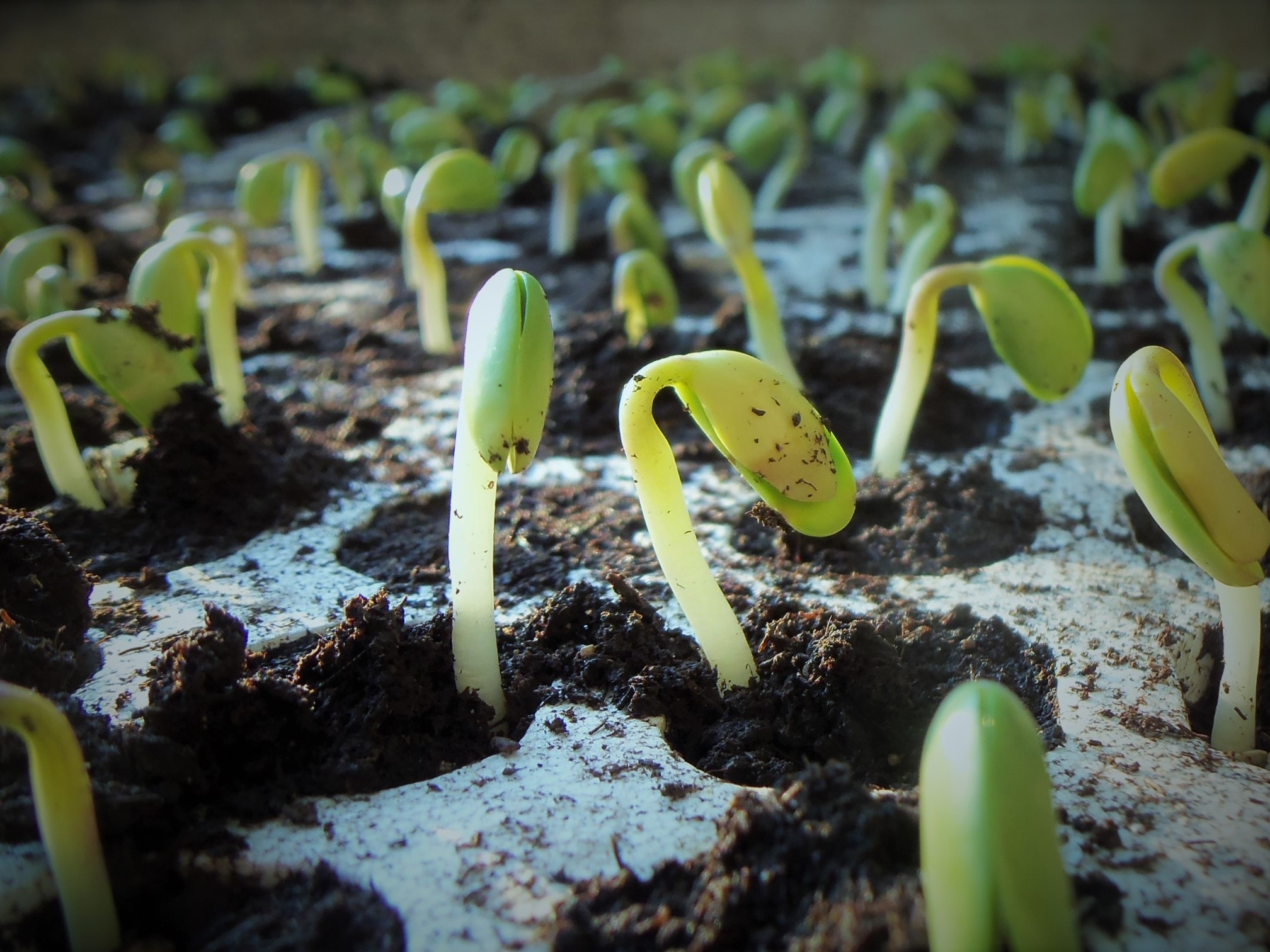
Seedlings sprouting (Pixabay)
MOST IMPORTANT FACTORS WHEN CHOOSING GROWING MEDIA
Chemical properties:
pH
The pH of growing medium is a measure of its relative acidity or alkalinity. pH values range from 0 to 14; those below 7 are acidic and those above 7 are alkaline. Most native plants tend to grow best at pH levels between 5.5 and 6.2, although some species are tolerant of higher or lower pH levels. The main effect of pH on plant growth is its control on nutrient availability. The availability of micronutrients, such as iron, is even more affected by pH. Iron chlorosis, caused by high pH, is one of the most common nutrient deficiencies of nursery stock. Exceptionally high or low pH levels also affect the abundance of pathogens and beneficial microorganisms.
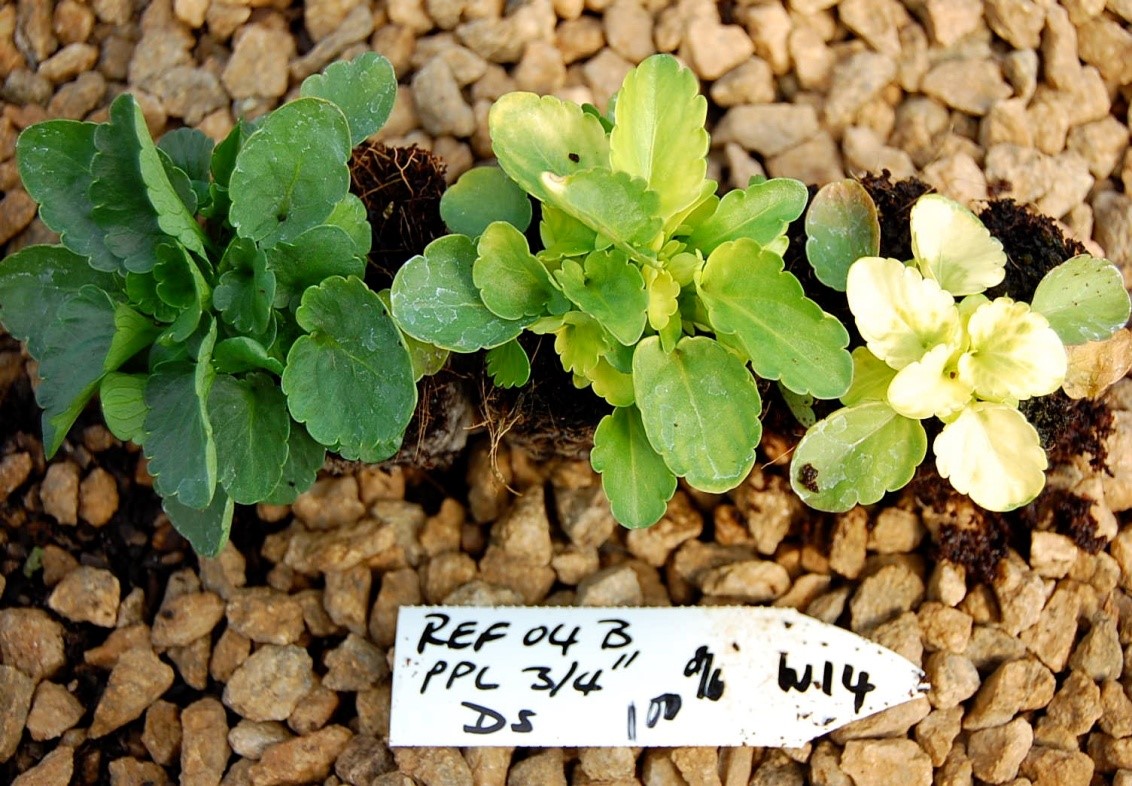
Photo showing Fe deficiency in a plant (pH = 7.3) (Lindi Grobler)
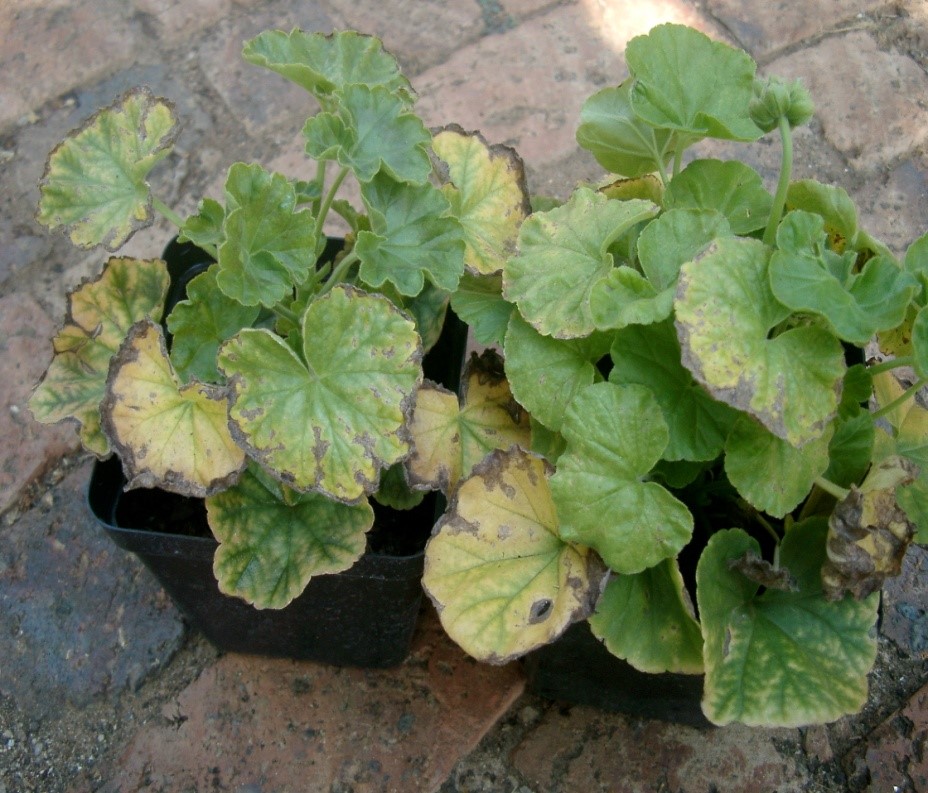
Photo showing Mn toxicity in a plant (pH = 4.6) (Lindi Grobler)
How do I increase the pH?
Addition of a liming material will raise the pH of your medium. This will however entail a number of additional controls such as quantity of addition, timing of application, grade of liming agent and the frequency of dosing. To find the optimum some time and research will be required on the specific blend and whether the mix is a potting blend or in soil.
How do I reduce the pH?
Acidifying growing media is often considered as a complex process as the additives and dosing is of extreme importance. Generally, to reduce the pH, sulphur is dosed. Due to availability and cost iron (ferrous) sulphate, phosphoric acid solution may also be used. The toxic side effects must be taken into consideration prior to dosing and the acidification of soils is only recommended when there is a low percentage of lime present due to the economic implications.
The pH affects the nutrient solubility and availability. A low pH causes micro nutrient toxicity, and a high pH causes nutrient deficiency.
Electrical Conductivity (EC)
EC is the measure of total dissolved salts in a solution, this influences a plant’s ability to absorb water. In horticultural applications, monitoring salinity helps manage the effects of soluble salts on plant growth. EC is a meaningful indicator of water quality, soil salinity and fertilizer concentration.
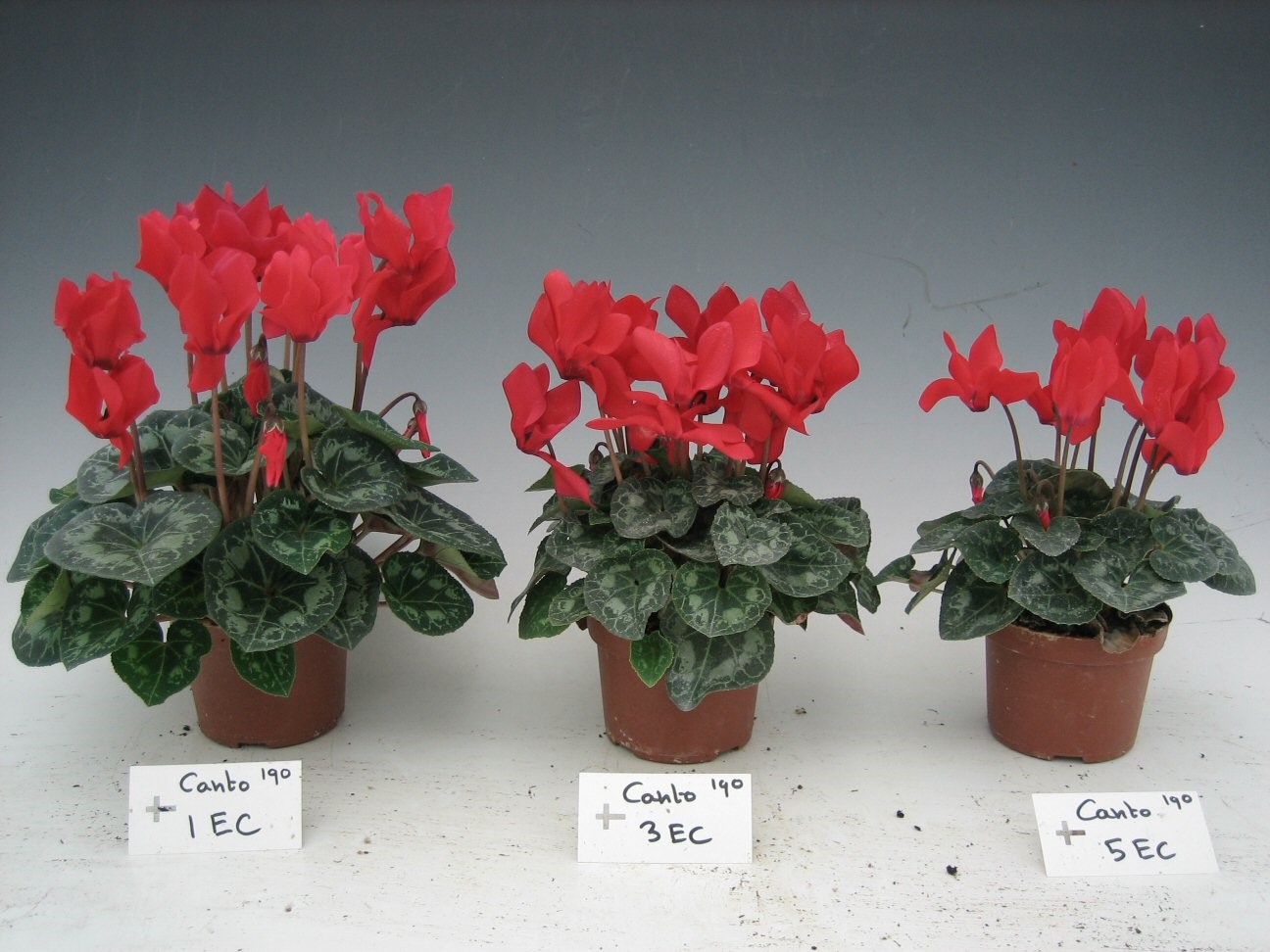
Photo showing the importance of electrical conductivity (EC) in plants (Lindi Grobler)
Cation Exchange Capacity (CEC)
CEC refers to the ability of a growing medium to hold positively charged ions. Because most growing media are inherently infertile, CEC is a very important consideration. In the growing medium, plant roots exchange excess charged ions for charged nutrient ions, and then these nutrients are transported to the foliage, where they are used for growth and development. Because the CEC of a growing medium reflects its nutrient storage capacity, it provides an indication of how often fertilization will be required.
Nutrients
Nitrogen
Nitrogen is such a vital nutrient because it is a major component of chlorophyll, the compound through which plants use sunlight energy to produce sugars from water and carbon dioxide (i.e., photosynthesis). It is also a major component of amino acids which are the building blocks of proteins
Without proteins, plants wither and die. Some proteins act as structural units in plant cells while others act as enzymes which are essential in many biochemical reactions on which life is based. Nitrogen is a component of energy-transfer compounds, such as ATP (adenosine triphosphate). ATP allows cells to conserve and use the energy released in metabolism. Finally, nitrogen is a significant component of nucleic acids such as DNA, the genetic material that allows cells (and eventually whole plants) to grow and reproduce. Without nitrogen, there would be no life as we know it.
Magnesium
Magnesium is an essential plant nutrient that has a wide range of key roles in many plant functions. One of magnesium’s well-known roles is in the photosynthesis process, as it is a building block of Chlorophyll, which makes leaves appear green
Potassium
Potassium is an essential plant nutrient and is required in large amounts for proper growth and reproduction of plants. Potassium is considered second only to nitrogen, when it comes to nutrients required by plants, and is commonly considered as the “quality nutrient.”
It affects the plant shape, size, colour, taste and other measurements attributed to healthy produce.
Plants absorb potassium in its ionic form, K+.
Potassium has many different roles in plants:
- In Photosynthesis, potassium regulates the opening and closing of stomata, and therefore regulates CO2
- Potassium triggers activation of enzymes and is essential for production of Adenosine Triphosphate (ATP). ATP is an important energy source for many chemical processes taking place in during plant growth and respiration.
- Potassium plays a major role in the regulation of water in plants (osmo-regulation). Both uptake of water through plant roots and its loss through the stomata are affected by potassium.
- Protein and starch synthesis in plants require potassium as well. Potassium is essential at almost every step of the protein synthesis. In starch synthesis, the enzyme responsible for the process is activated by potassium.
Potassium deficiency might cause abnormalities in plants, usually the symptoms are growth related.
Cholrosis – scorching of plant leaves, with yellowing of the margins of the leaf. This is one of the first symptoms of Potassium deficiency. Symptoms appear on middle and lower leaves.
Slow or Stunted growth – as potassium is an important growth catalyst in plants, potassium deficient plants will have slower or stunted growth.
Poor resistance to temperature changes and to drought – Poor potassium uptake will result in less water circulation in the plant. This will make the plant more susceptible to drought and temperature changes.
Defoliation – left unattended, potassium deficiency in plants results in plants losing their leaves sooner than they should. This process might become even faster if the plant is exposed to drought or high temperatures. Leaves turn yellow, then brown and eventually fall off one by one.
Other symptoms of Potassium deficiency:
- Poor resistance to pests
- Weak and unhealthy roots
- Uneven ripening of fruits
Manganese
Manganese is one of nine essential nutrients that plants require for growth. Many processes are dependent on this nutrient, including chloroplast formation, photosynthesis, nitrogen metabolism and synthesis of some enzymes. The role of manganese in plants is extremely crucial. Deficiency, which is common in soils that have neutral to high pH or a substantial deal of organic matter, can have a significant effect on the health and growth of plants.
Physical Properties
Medium texture & structure
The texture of growing media can either be defined as “fine” or “coarse”, and this is determined by the particle size distribution of the growing medium. When one is familiar with the texture of the growing media, it allows speculation as to other properties of the growing media, for example, fine growing media has a difficult water infiltration rate, and is easily waterlogged, where a course growing media has rapid infiltration, rapid drainage and a lowered water holding capacity.)
The structure of the media is determined by the particle size distribution, which is the percentage fine or course particles in a growing media.
Aeration of medium
The air-filled porosity of the media is the sizes of the pores in the media or “openness” of the media. The smaller pores filled with water and the larges pores are filled by air. The water that can be found in the largest of the smallest pores is available to the plant, and the water found in the tiniest pores are unavailable to the plant.
The proportion of air to readily available water is equal to the proportion of pores of different sizes. The larger pores the growing media has, the more air it holds. Many small pores are equivalent to a high ability to hold water.
Air filled porosity should increase as the height of a container increases, the air porosity will also determine the irrigation frequency and quantity. The importance of air filled porosity correlates to the respiration process which occurs at the root structure of the plant as well as the incidence of waterlogging. Providing sufficient aeration and reducing the likelihood of waterlogging encourages healthy root and stem growth avoiding root rot and stunted plant growth.
Water holding capacity
The air-filled porosity determines the infiltration rate. One must have a balance between air filled porosity and available water, and the readily available water should be as high as possible without significantly impacting the supply of air to the root system.
Each medium release water according to the suction supplied by the roots of the plants. Therefore, a growing medium blend must accommodate the amount of water required by the plant as well as the frequency of irrigation. Selection of a suitable growing medium may reduce the frequency of irrigation required due to the mediums ability to store and supply water which may have been otherwise lost to evaporation and drainage.
DIFFERENT KINDS OF GROWING MEDIA
Peat moss
Peat moss is a partly decomposed material containing remains of plants growing in swampy areas and is usually very acidic.
Sphagnum peat moss is currently the most common organic component of growing media. Although types of peat moss may appear similar, they can have very different physical and chemical properties.
Saw dust / saw shavings
Raw sawdust, with its high C:N, can negatively affect nutrient availability, especially nitrogen but its properties can be improved with composting. Additionally, because of the inherent differences in chemical properties between different woods, the suitability of sawdust as an organic growing media component is extremely variable. Some species produce sawdust with phytotoxic effects. Only consider using sawdust from sawmills because other wood residues, such as those from treated boards, may contain preservatives or harmful chemicals. Sawdust from coastal sawmills can contain high levels of salts, so all potential sources need to be tested before general use in the nursery.
Coir/Coir fibre/Coco peat
A by-product of processing coconut husks is known as coir dust, coco peat, or simply coir. This material has proven to be an excellent organic component for container growing media and is readily available in some tropical locales. Coconut coir has many desirable qualities: high water-holding capacity; excellent drainage; absence of weeds and pathogens; physical resiliency (withstands compression of baling better than Sphagnum peat); slow decomposition; easy wettability; and acceptable levels of pH, cation exchange capacity, and electrical conductivity. Coir is very similar to peat in appearance and structure, and, like peat, physical and chemical properties of coir can vary widely from source to source. Coir is low in nitrogen, calcium, and magnesium but can be relatively high in phosphorus and potassium. Excess salinity and phenolic compounds in coir can be a problem in areas with inadequate quality control. In addition, some coir sources have reportedly contained chlorides at levels toxic to many plants. Thus, it is very important that salts and other compounds are thoroughly leached with fresh water before use.
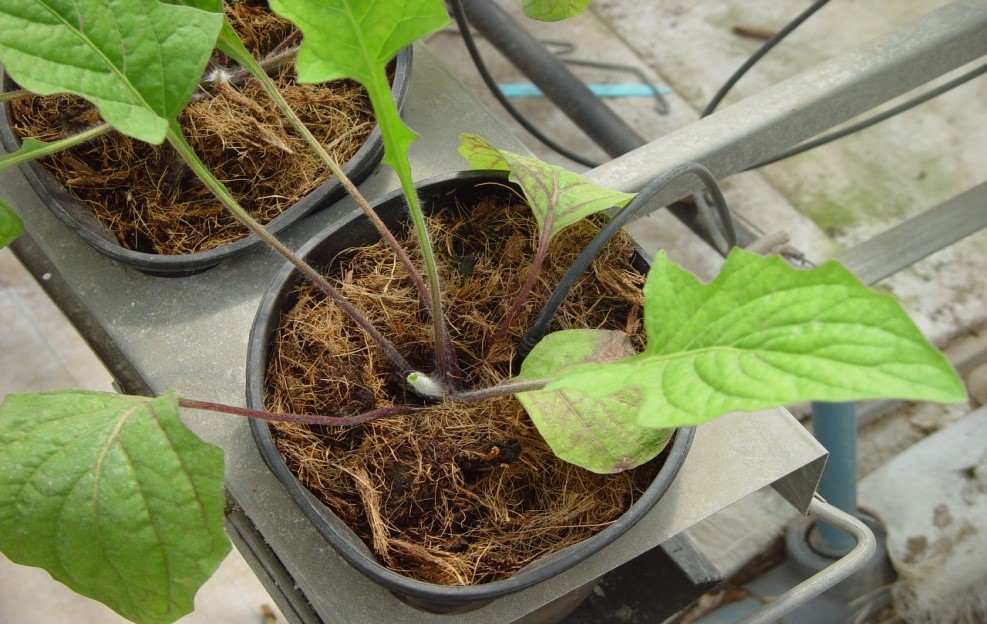
Plants growing in coir (Lindi Grobler)
Perlite
Perlite is a siliceous material of volcanic origin, and supplies no nutrition to plants. Perlite particles have a unique closed-cell structure so that water adheres only to their surface; they do not absorb water as peat moss or vermiculite do. Therefore, growing media containing perlite are well drained and lightweight. Perlite is also rigid and does not compress easily, which promotes good porosity. Because of the high temperatures at which it is processed, perlite is completely sterile. It is essentially infertile, has a minimal CEC, and has a neutral pH. Perlite is typically included to increase aeration, and commercial mixes contain no more than 10 to 30 percent perlite.

Perlite used as a growing media
Vermiculite
Vermiculite is a common component and is a hydrated aluminium-iron-magnesium silicate material that has an accordion-like structure. Vermiculite has a very low bulk density and an extremely high water-holding capacity, approximately five times its weight. This material also has a neutral pH, a high CEC, and contains small amounts of potassium and magnesium. Vermiculite deteriorates when wet as the particles collapses and this should be accounted for when selecting growing media blends.
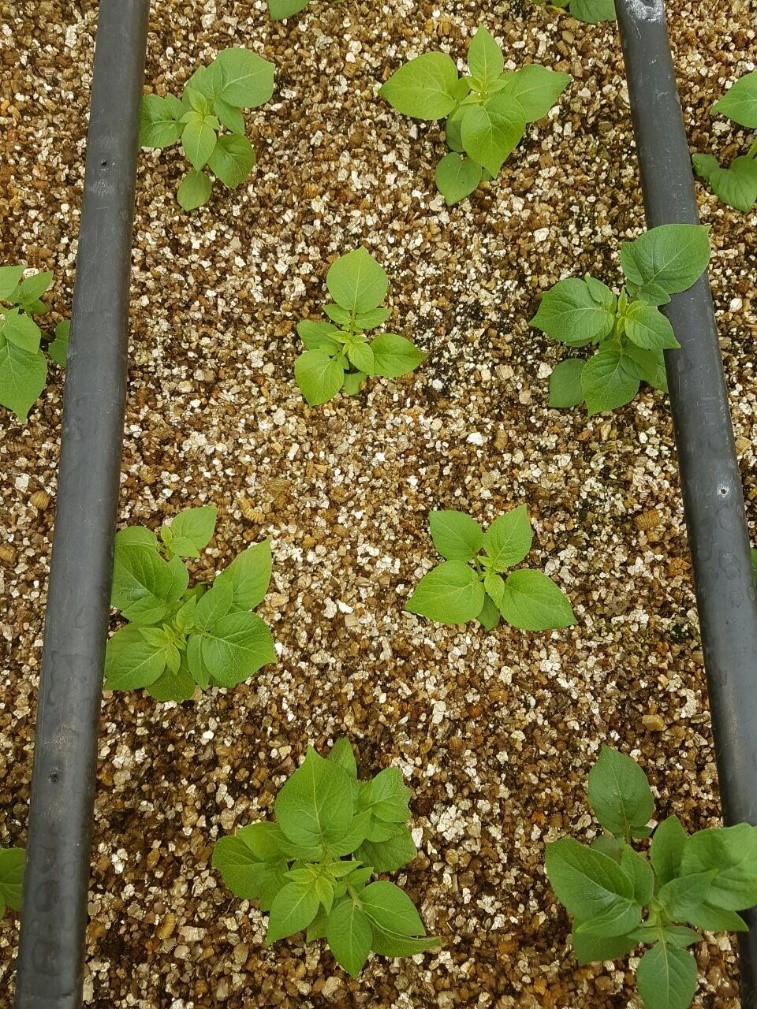
Potatoes growing in SunPerl Vermiculite (Sun Silicates)
Pumice
Pumice is a type of volcanic rock consisting of mostly silicon dioxide and aluminium oxide with small amounts of iron, calcium, magnesium, and sodium. The porous nature of pumice particles improves aeration porosity but also retains water within the pores. Pumice is the most durable of the inorganic ingredients and so resists compaction. Pumice has a neutral pH without CEC and therefore does not interfere with the availability of nutrients.
One could either use these media on their own or combine the media to create a mix.
WHAT INFLUENCES MY CHOICE WHEN CHOOSING A GROWING MEDIA?
The 2 most important factors when choosing a growing media are
The pH
When managing the pH, it is important to know the media pH one started with. Also, the changes in the pH must be monitored as the plants develop (the pH provides an indication on the availability of nutrients).
The container used to plant in
When managing the containers, one must choose containers according to the environment, water quality and the growing media that will be used. Factors that must be considered is the depth of the container, volume of the container, shape of the container, width of the container and the draining hole.
Using containers that are too small
Soil serves as the main source of nutrients for any plant. With less soil in a smaller container, there are fewer nutrients available for the plant’s root system. A container that is too small can constrict the plant’s roots, especially plants with big roots. The roots can get packed in without having enough room to spread out. If this happens, the plant’s growth may slow down. Plants may also be tipping over because of the extra weight in comparison to the container.
One way to know if your plant needs a bigger container is to look for roots poking out of the drainage holes in the bottom. A container that is too small also won’t hold enough water to support the plant. And the soil dries out quickly. You might notice that the plant shows signs of drought sooner if the container is too small.
Using containers that are too large
It may seem like going with an over sized container is better so you can avoid the crowded root situation. But a container that’s too big for your plant can also have negative effects on its growth. A container that is too large for a plant can hold too much water in the soil or take too long to dry out, which can lead to mold growth, rot and root diseases. Too large of a container can also make it difficult to keep the soil firmly packed around the plant’s roots.
How to choose a proper size container
The best container for each plant depends on the size of the plant and its needs. A container should allow the plant’s root system to spread out somewhat and drain well. This means that the container should not be soaked after it is watered because the water should drain out the bottom. If your plant is currently in a container that’s too small, move it to a container that’s about 5 cm to 10 cm larger in diameter.
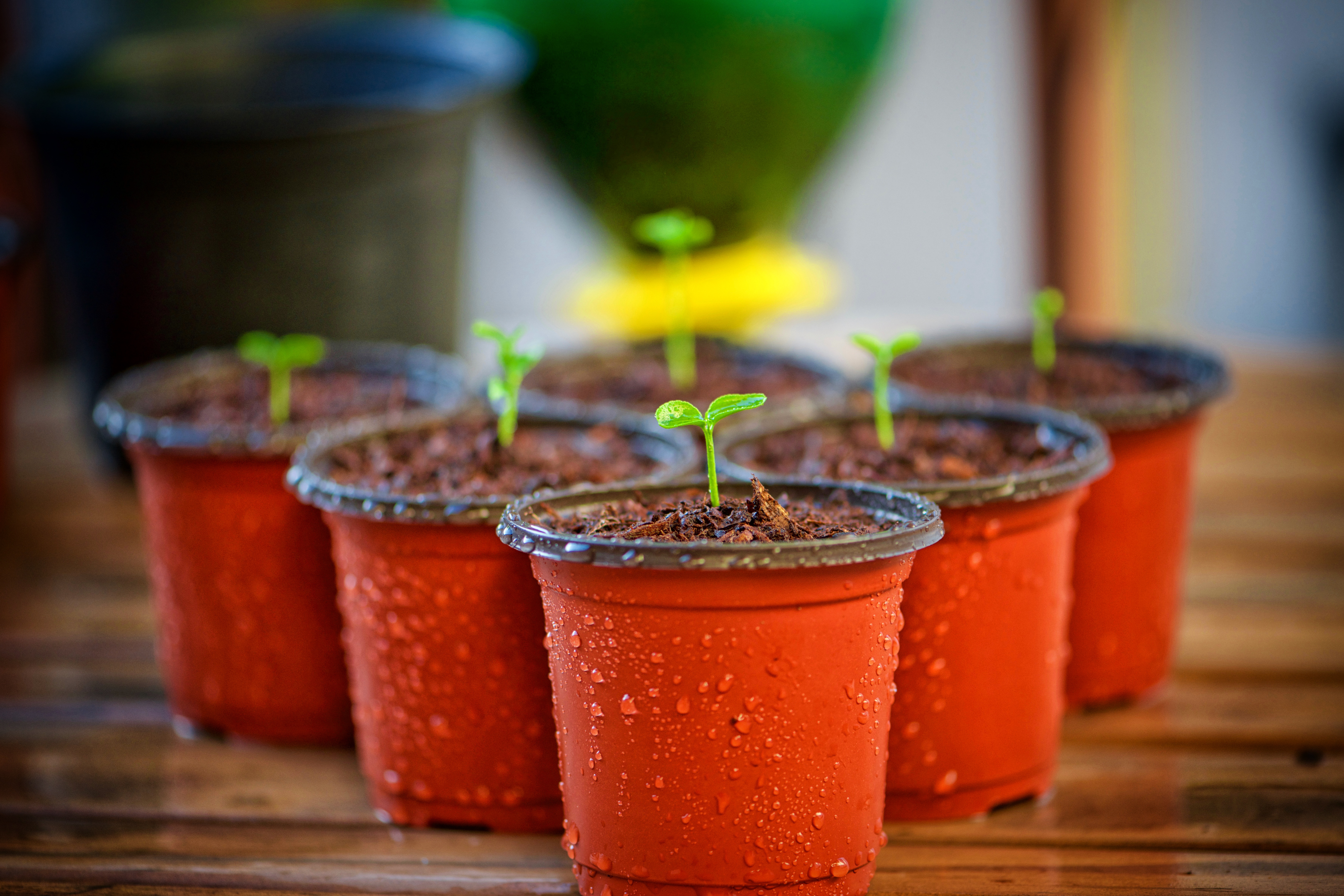
Choosing the right size container is crucial when planting as it leads to the successful growth of the plant
For more information regarding growing media, please visit www.sunsilicates.co.za, of contact us at 011 824 4600 with any questions or queries.


